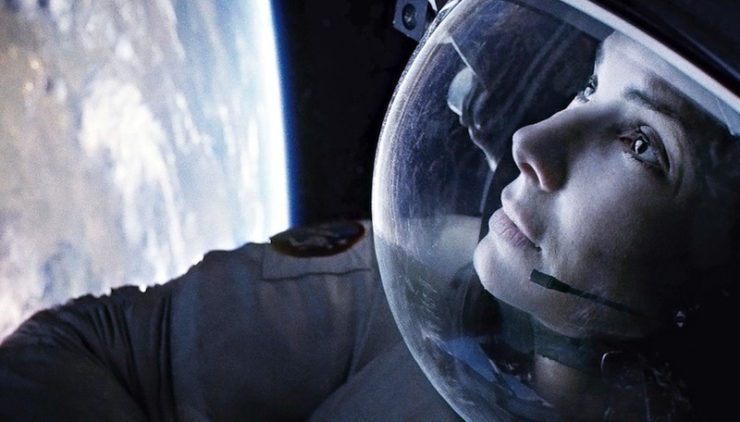While researching the history of the space program for a previous article, I ran across the phrase “Godspeed.” Uttered spontaneously by Mercury astronaut Scott Carpenter in the early days of NASA, it’s a phrase that, while not overtly religious, feels prayer-ish—and its repetition, and use as sort of secular benediction in the SFF community, became increasingly interesting to me the more I researched. The more I looked into it, the more I came to think the phrase itself sets the tone for our coverage of space exploration, both in contemporary news reports and fictional portrayals. Where you might expect films about feats of engineering and math to be quite secular and scientifically rigorous, there was often an interesting spiritual dimension to our space media. What I began to realize was that the vast majority of US-made space films use the space program to explore the German concept of the Heilige, or numinous.
As a person who used to study religion for a living (and who still studies it in their off-hours) I found this—excuse my use of a technical term—neat. In pursuit of this neatness I’m embarking on a journey across 40 years of film to look at how films have created a conversation between the realm of religion and the realm of rocketry. Join me, won’t you?
Do You Have a Moment to Talk About Cosmism?
First, a little historical background. The Russians kind of made a religion out of their desire to explore space. It’s called Cosmism, and it began at the turn of the 20th Century, predating the Bolshevik Revolution. The philosophy was developed by Nikolai Fyodorovich Fyodorov, who melded a type of futurism with devout Russian Orthodox Christianity. He believed that humans were still at an early phase of evolution, and that mortality was evidence of our lack of development. He theorized that through scientific advancement we could become immortal, and then resurrect all of our ancestors. Then we would dedicate our immortal lives to further scientific advancements, and space and ocean exploration. He was an influence on Konstantin Tsiolkovsky, who went on to become one of the founding fathers of rocket science. Tsiolkovsky worked out formulae for space travel and rocket propulsion, designed space elevators, and had the first aerodynamics lab in Russia—in his apartment. All of this work was in service of his particular flavor of “panpsychism,” the belief that there was an overarching consciousness to the universe, and that humans were essentially puppets acting out that Capital-C Consciousness’ will. Part of this will was that humans would spread across space. When the succeeding generation began developing the Russian space program, they revered Fyodorov and Tsiolkovsky, holding them up as grandfathers of space exploration. Right from the start, the roots of the Russian program were fed by a type of spirituality that was vastly different from the climate of America’s forays into space.
After the Revolution Cosmism was tied into the whole Soviet mythos, and the idea that Russian-flavored communism, being correct, would naturally spread out into the stars, where happy workers could live in harmony in colonies on the moon. This faith was extremely practical, as it was used to encourage schoolchildren to study math and science, to inspire rocketry clubs, and more generally to bolster the ideal that every person could be well-educated and intelligent despite their pre-Revolution class standing.
In 1961 the Russians shot pilot Yuri Gagarin into space in what was essentially a glorified tin can, and when he came back alive he obviously became a hero around the world. But in Russia, he essentially became a sort of space icon. I mean in the old school, Russian Orthodox sense of “ikon” and he still is—if you look at photos of the ISS, you’ll see images of Gagarin alongside those of Christ Pantocrator and various ikons of the Theotokos. Gagarin himself became the subject of a religious dispute, with the anti-religion Soviet state claiming that he said some variant of “I don’t see any God up here”—a phrase that doesn’t turn up in any of the recordings of the flight. That statement seems to have come from Nikita Khrushchev’s speech at 1961’s meeting of the Central Committee of the Communist Party of the Soviet Union, which was actively trying to break Russians away from the Orthodox Church. (Gagarin did, however, say, “Let’s go!” while he was being launched into space, because he was cool as shit.) Gagarin swiftly became an international superstar, a Russian hero, and the central saint of Cosmism.
Buy the Book
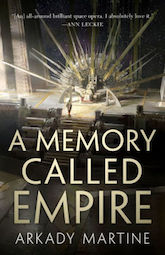

A Memory Called Empire
Meanwhile, the American space program really got off the ground (…sorry, I’ll stop) because of Wernher von Braun. Von Braun had been a rocket scientist with Cosmist leanings in Germany, and worked with the Nazis, using the rocketry he had hoped would take humanity into space to bomb London. As the Third Reich began to fall apart, he and his brother knew they would have to defect, and chose to surrender to U.S. troops rather than Russian. Writing about this decision, Braun explicitly stated that he was guided by religious belief:
We knew that we had created a new means of warfare, and the question as to what nation, to what victorious nation we were willing to entrust this brainchild of ours was a moral decision more than anything else. We wanted to see the world spared another conflict such as Germany had just been through, and we felt that only by surrendering such a weapon to people who are guided by the Bible could such an assurance to the world be best secured.
But, it’s important to remember that he was writing years later, after he had lived on a series of Southern American military bases, had converted to a particularly American brand of evangelical Christianity, and eventually left that denomination for the upwardly mobile Episcopal Church. The way he tells his story, he makes the decision to work with the U.S. because he wants to help the God-fearing nation reach space first. This feeds into a general conversation around the space program, where a monotheistic America was pitted against the godless communism of Russia.
The nascent space program toed the same bland, vaguely Christian ideals that all aspects of American public life were expected to uphold. The U.S. had just spent the 1950s adding “In God we Trust” to our money and “Under God” to our Pledge of Allegiance, while the Civil Rights Movement was making headway by using the rhetoric of Black Christianity. The U.S. had never undergone the mass secularizing effect of a Communist revolution or a Nazi regime, so “science” and “faith” largely remained separate spheres, and there wasn’t a sense that space exploration could itself inspire religious feeling—and there certainly wasn’t an opportunity for any sort of sci-fi religion to crop up as Cosmism has in Europe and Russia.
The Apollo 8 mission even included a Christmas Eve reading from Genesis that was broadcast as Bill Anders, Jim Lovell, and Frank Borman orbited the Moon for the first time. This led to some interesting fallout: the founder of American Atheists, Madalyn Murray O’Hair, brought a lawsuit over the broadcast, saying that since the astronauts were government employees, their public promotion of a religious text on national television went against the separation of Church and State. The court dismissed the case, citing a lack of jurisdiction… because it happened in space.1
It also impacted a later mission. Being a devout Presbyterian, Buzz Aldrin wanted to add a sacred element to his time on the moon. He decided to celebrate Communion (Comm-moon-ion? Sorry. I’m so, so sorry.) and initially wanted to broadcast it back to Earth, but after the controversy of the Genesis reading NASA discouraged it, with Deke Slayton asking him to keep things “general.” So rather than broadcast exactly what he was doing, he sent out a more neutral message:
I would like to request a few moments of silence… and to invite each person listening in, wherever and whomever they may be, to pause for a moment and contemplate the events of the past few hours, and to give thanks in his or her own way.
Later on he mused on even this, writing in Magnificent Desolation: The Long Journey Home from the Moon: “Perhaps, if I had it to do over again, I would not choose to celebrate communion. Although it was a deeply meaningful experience for me, it was a Christian sacrament, and we had come to the moon in the name of all mankind—be they Christians, Jews, Muslims, animists, agnostics, or atheists.”
After that, religion and space travel coexisted peacefully, with various Popes sending icons and prayer cards up occasionally.
It wasn’t until the ’80s, when Saudi prince Sultan bin Salman bin Abdulaziz Al Saud joined a Discovery mission, that a new wrinkle emerged: how can Muslims practice in space? How can you face Mecca for an entire prayer sequence when you’re zipping around the planet? How can you bathe correctly when you don’t have running water? When Malaysian Muslim Sheikh Muszaphar Shukor planned his trip to the ISS, the National Fatwa Council developed the “Muslim Obligations in the International Space Station” list, which allowed Shukor and future astronauts to use a modified version of the ritual:
In other words, religion works in space pretty much the way it works here: some people practice, some people don’t, and if everyone’s cool about that and respects each other, daily life can chug along just fine, even in Zero G. But what gets more interesting to me is that in media about space travel, things tends to get a little weirder. Sometimes the films embrace the concept of Cosmism (without ever acknowledging the term). Sometimes they seem to want to check in with the religious sphere of life on Earth to reassure their viewers that religion is still important, as though it’s in some kind of death match with science. And for the most interesting aspect, well, I have to dive into a German theological term from the turn of the last century.
As one does.
Defining the Numinous!
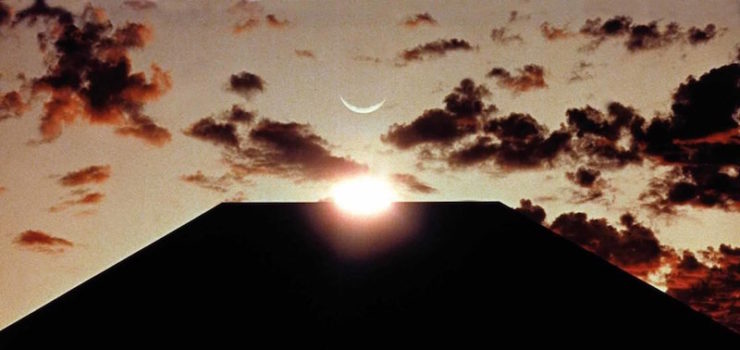
In 1917, the German theologian Rudolph Otto published a book called The Idea of the Holy. Otto tried to parse out what people meant by the term “holy”—where often people would use the phrase to just mean “super good” like “a holy man” is morally superior to other people, Otto was interested in another aspect—the “numinous,” or “wholly other.” This “other” was an experience of awe that transcended every day life, and left the person experiencing it “utterly abashed.” He described it as a mysterium tremendum—terrifying mystery—but also as the mysterium fascinans—fascinating mystery—trying to get at the idea that person could be both terrified of this sense of awe but also drawn to it.
Now, for Otto, a sturdy German Protestant, this was all just a bunch of fancy language to try to define God, and parse out people’s religious tendencies. He also tried to use this idea of the numinous as a touchstone as the study of religion was formalized—if everyone could agree that all religions have their own idea of the numinous, then scholars could use that as a jumping-off point as they worked out how to study the differences and similarities across different faiths. But as the century unrolled, lots of theologians and philosophers who followed Otto’s ideas wanted to distance themselves from religion entirely, because it became increasingly difficult to justify sturdy German Protestantism after the Holocaust. So some people took the idea of the “numinous” and ran with it, unshackling it from the assumption that the mysterium tremendum was necessarily God and instead proposing that people could have that experience in response to all sorts of life events. Jung used the idea as he developed his version of psychotherapy, and Aldous Huxley wrestled with it in The Doors of Perception.
And, I would argue, most of the films about space take the numinous and use it to create a surprising emotional undercurrent to largely secular stories.
So you remember how I said Cosmism was a Russian thing, primarily? And the idea of the numinous is German? Where things get interesting to me is that when Americans started making movies about the space program, they took every opportunity to insert Cosmism and numinous-ness into their films—often even adding them when their historical source material didn’t in any way lend itself to a more spiritual treatment.
If you’re looking for a sense of inexpressible awe in the face of a terrifying mystery, a GIANT SPACE MONOLITH ticks every box, and then it makes primordial ooze evolve into more boxes and ticks those too. But 2001: A Space Odyssey is really more of an alternative history of evolution, taking us into humanity’s far future, giving us seemingly sentient AI, and positing a path for us to take that goes so far beyond our current space program tech that the film becomes more of a fantasy than anything else. Because of that I’m going to tip my film analysis hat to it, and move on to films that are based more in our current reality.
The Space Program, The Numinous, and Our Fictional Near Futures
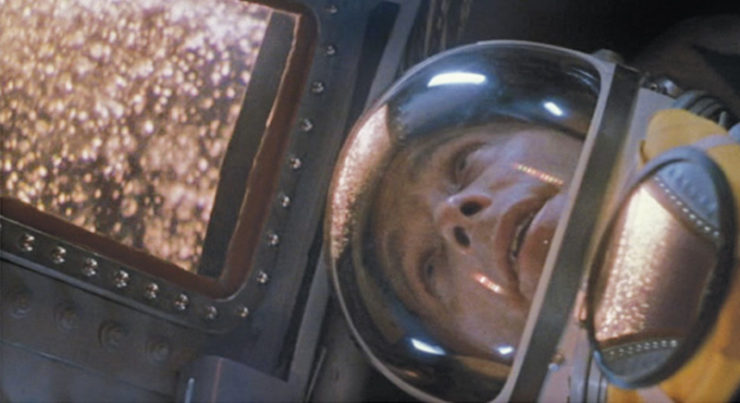
When Scott Carpenter says “Godspeed, John Glenn,” in The Right Stuff, this is the film adapting a real historical moment, when Carpenter spontaneously added the phrase to a prayer said by Tom O’Malley as he initiated the launch sequence for Friendship 7. Now, if you were a medieval pilgrim, and someone said “Godspeed” to you, what they were literally saying was “May God help you prosper while you’re on your trip” because they knew it would be a long time until they saw you again. (If you want to be super literal, it means “Live Long and Prosper.”) But when Carpenter said it he gave it a different spin. As he talked about it later: “In those days, speed was magic because that’s all that was required… and nobody had gone that fast… [I]f you can get that speed, you’re home-free, and it just occurred to me at the time that I hope you get your speed. Because once that happens, the flight’s a success.” The film includes Carpenter’s iconic send-off, but not O’Malley’s prayer. Instead of including a nod to a traditional religious act, it goes in a very interesting direction that embraces the idea of the numinous in a way that is entirely divorced from Protestant and Catholic religious traditions of its astronauts. The Right Stuff ends up setting a certain spiritual tone that all the subsequent space movies seem to either hold to, or aggressively avoid.
Gordon Cooper, another Mercury 7 astronaut, travels to Australia to speak with Glenn as he travels in orbit. Once he gets there and checks in with Houston, he learns that alarms are going off, and that NASA is worried that the heat shields on the capsule are faulty. Everyone waffles on whether or not to tell Glenn, since obviously if the heat shields go, he’s not making it back to Earth. But it turns out that he has his own news to report: there are orange sparks flying around the windows of his capsule. Are they alive somehow? Are they residue from the ship? He tries to describe them and dubs them fireflies. Again, this is based in a real incident. But the film allows for a sense of mysticism by focusing much more on Glenn’s wonder at his space fireflies than, say, cutting back to the guys in Houston suggesting scientific explanations.
A scene later, the film takes a really interesting step—and a huge departure from Tom Wolfe’s book—by introducing an Australian Aboriginal holy man who lights a fire and dances around it at the same moment that Glenn sees the space fireflies. The juxtapositions in the scene implies pretty strongly that A) the holy man is praying for John Glenn; B) his fire is somehow creating the space fireflies; and C) that he also, maybe, saves John Glenn’s capsule as it re-enter’s Earth’s atmosphere? This plot twist comes out of nowhere, in an otherwise realistic film. Religion is coded here as a primitive impulse, the domain of a man who is in touch with the earth and cosmos in a way that the white astronauts are not, but it’s also correct. Kaufman even said, “I thought about adding a mischievous element of humor. I was thinking that people have been in touch with the mysteries of outer space since the beginning of time.” Rather than sticking to the science and realism of Wolfe’s book, Kaufman wanted to leave room for mystery—but apparently he didn’t want to tie that mystery down to any of the staid religious traditions that were practiced by the real astronauts in their daily lives. My thought is that Kaufman felt that falling back on those rituals would rob the scenes of the sense of the numinous—but why is showing audiences a vague, out-of-context Aboriginal ritual somehow better?
Of the rest of the historically-based space program films, two seem to ignore the idea of the numinous completely.
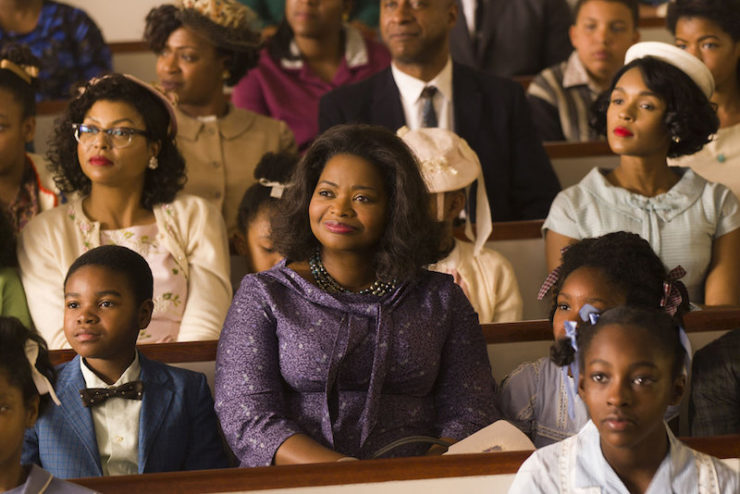
Apollo 13 and Hidden Figures depict religion as part of life on Earth—largely the domain of women. Apollo 13 portrays Marilyn Lovell as a superstitious woman, worrying about signs and omens while her husband charges to the moon using SCIENCE. When he’s in trouble, the family priest is called in, but he sits beside her squeezing her shoulder. We don’t see him pray, or say anything inspiring to Marilyn or the kids—he actually doesn’t say anything at all, while all the male astronauts and engineers get at least a few lines. He’s a back-up plan in case the men die on re-entry. In Hidden Figures, the women attend church together with their children in a typical Hollywood Black Church Scene. The preacher blesses the women and men of the space program from the pulpit, and ties their faith in God to the inevitable forward motion of the United States, and, it’s implied, the progress of civil rights. Both of these movies are firmly based in historical fact, and incorporate their subjects’ religious lives accordingly.
The rest of our space exploration pantheon, from Contact up to The Martian, tend toward a much more complex exploration of the role of religion in space travel, often edging into Cosmism, and always making room for the idea of the numinous—even in works that are otherwise quite secular.
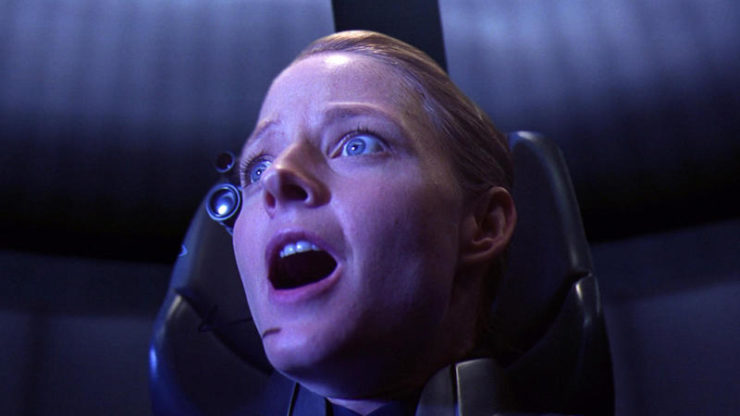
Robert Zemeckis’ adaptation of Carl Sagan and Ann Druyan’s novel strikes a precise balance between scientific rigor and its own mystical element. It’s also fascinating because you think you’re getting one movie, until the film suddenly turns into something else, and then suddenly turns into a third, even less expected thing:
- The movie I thought I was getting: Ellie Arroway works for SETI and wants to make CONTACT with aliens!
- The movie I initially got: Ellie Arroway works for SETI and wants to make CONTACT with aliens because she misses her father, and also she has to navigate near-constant misogyny, and also she hooks up with Matthew McConaughey, who is named Palmer Joss for some inexplicable reason. I can handle this movie, it’s cool.
- But then suddenly it became: Aliens have sent us some tech, and we’ve built a ship to go visit them, and Ellie Arroway wants to go meet the aliens, but suddenly her lack of religious faith is a hot-button issue, as is her past hook-up with Matthew McConaughey! …OK, movie, this is getting a little weird, but I’m willing to come with you on this journey.
- BUT THEN, just as I’d settled into that film, it became: Religious extremists have sabotaged the mission! Ellie’s sexist nemesis is dead! Eccentric billionaire S.R. Hadden has funded Ellie! She gets to meet the aliens! But in order to do so she goes through a hallucinogenic quasi-visionary experience and travels to a ’90s screensaver to meet an alien who transforms itself into her dead father in order not to freak her out!
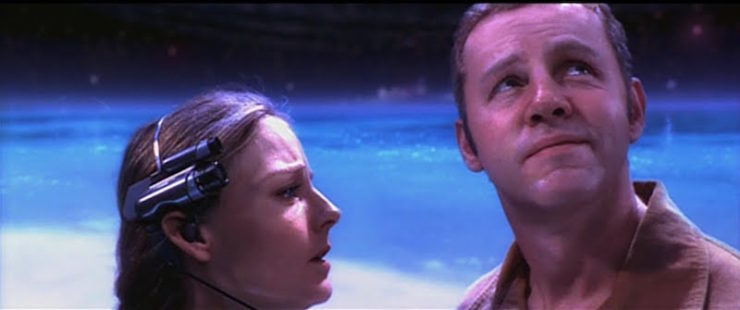
Whew.
This makes for a movie that adheres pretty closely to the Cosmism idea, as Ellie’s sense of wonder and joy in the universe is tied to space exploration itself. It’s also, of all the films I’ve looked at, the one that is most dedicated to this idea of the numinous, and the most dedicated to keeping that concept separate from religion. In fact, the film dramatizes the wrestling match between science and religion repeatedly by having various religious extremists protest and sabotage the alien technology, and by cutting to scientists and religious leaders debating the ethics of alien contact on television. It takes as a given that certain monotheisms (I’m not naming any names here) would try to elbow their way in and direct the conversation. It also pushes back on conventional monotheism in a startling way by making Arroway’s agnosticism a core element of the film.
When she’s competing with her old boss David Drumlin to earn a spot in the ship, she easily proves herself physically and mentally—and she should have an edge because it was her SETI work that identified First Contact, long after Drumlin had scoffed at the project and told her she was a fool to continue. But when Congress holds a hearing to weigh their choices, Arroway’s dedication to science trips her up. The Chairwoman of the panel tells Arroway that they’re impressed with her, and that they’re prepared to move on to a final statement from her. Sentient puka shell necklace Palmer Joss interrupts with a final question: “Would you consider yourself a…spiritual person?” Ellie, reluctantly, says, “I don’t understand the point of the question? I consider myself a moral person.” The chairwoman tries to take over again, saying, “I’m sure we all agree you’re a moral person, but I think what Mr. Joss is indeed asking is—” And then Palmer Joss interrupts again, asking, “Do you believe in God, Dr. Arroway?” Which of course, the two of them have had long conversations about this, occasionally while naked?

He knows the answer is no, and can only be asking this either to catch her out, or in the hopes that she’ll lie. Which, of course, Ellie does not: “As a scientist, I rely on empirical evidence, and I don’t believe that there’s data either way.” When she tries to protest against the relevance of the questions, another panelist chimes in: “Dr. Arroway, ninety-five percent of the world’s population believes in a supreme being in one form or another. I believe that makes the question more than relevant.” Ellie realizes she’s not getting the assignment. But rather than lying, she says, “I believe, um…I believe I’ve already answered that question.”
Then Drumlin gets his turn, and says that sending a scientist “who didn’t put our most cherished beliefs first” would be a “betrayal” of all that God has given humanity. Of course he gets the gig, and no one questions his terrifying use of the word “our.”
Palmer comes to visit Ellie while she’s packing, and when she asks why he sabotaged her, his answer seems almost reasonable: “Our job was to select someone to speak for everybody. And I just couldn’t in good conscience vote for a person who doesn’t believe in God. Someone who honestly thinks the other ninety-five percent of us suffer from some form of mass delusion.” See? Reasonable. But then Ellie comes back with: “I told the truth up there. And Drumlin told you exactly what you wanted to hear.”
Ouch.
This section of the film is incredibly painful to watch, as a dedicated scientist is interrupted, talked over, mocked, and dismissed, all because her intellectual rigor is held up as a character flaw. (It’s especially shitty because the person who undoes her is possibly the most Matthew McConaughey character Matthew McConaughey has ever played. Every time Palmer Joss speaks it’s like a super-hot, moist surfer is enveloping you in a hug, only to have his hand-whittled wooden cross whack you repeatedly on the temple while he drones on about love. Call it the McConaughmous.) But it is a fascinating riff on the Culture Wars. We see how different strains of religious thought jostle for supremacy, the way a particularly bland brand of Protestantism jockeys to represent “religion” for humanity, the way more extreme factions turn to terrorism, and how the scientific community has to dance across eggshells to get their work done without offending anyone. What’s extra great about this movie, though, is that it shows how this isn’t good for anyone. The religious faction swallows Drumlin’s lies, Drumlin gets blown up by one of the extremists, Palmer Joss almost loses any hope he had of creating a real relationship with Ellie, and the whole project would have gone kerplonk kerplooie if S.R. Hadden, Eccentric Billionaire, hadn’t swooped in to fund a second attempt.
This second attempt is the part of the film that commits fully to the idea of the numinous, and it’s vital that they’ve established Ellie as an ultimate agnostic. Ellie is taken through a wormhole, sees a spectacular light show which also seems to have an emotional component, and attempts to describe it by saying “Some celestial event. No—no words. No words to describe it. Poetry! They should’ve sent a poet. So beautiful. So beautiful… I had no idea.” The travel itself becomes a spiritual journey for her, because it’s a thing that has to be experienced to be understood, rather than analyzed. Once she’s through the wormhole, she has a conversation with an alien who has transformed to look like her father, so she’s able to make CONTACT and also have a final conversation with her dad. The film does some elegant handwaving around all of this, showing that the alien ship didn’t record any visuals of Ellie’s journey, and that to the observers left back home the whole “trip” seems to have only taken a few minutes. But the machines recorded eighteen hours of static. This way the film can give us a record of a truly numinous experience, in which Ellie came face-to-face with something inexplicable, and felt all the requisite awe, but since the aliens are indeed “wholly other,” those who didn’t come on the trip have no way to understand what she experienced. It also puts her in the position of having to have faith in something ineffable, ironically poking her for all the times she scoffed at Palmer Joss. The film creates room for religious people and skeptics alike.
But at its heart, Contact is science fiction, maybe verging on science fantasy given the handwavy alien tech. It was really about humans trying to apprehend an intelligence different from their own, like when we watch videos of octopi escaping their tanks. Gravity, however, was billed as a more-or-less accurate, realistic survival thriller. It is not.
Gravity is basically a religion movie in a spacesuit.
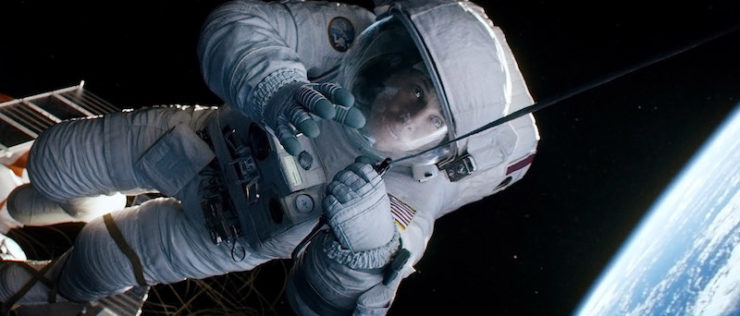
Arguably it is the main character’s rejection of the numinous that creates most of the film’s tension. Newbie astronaut Dr. Ryan Stone (Sandra Bullock) is stranded in space when a debris storm destroys her ship and leads to the deaths of the rest of the crew. She has to travel from the wreck of the Explorer to a Soyuz capsule to Tiangong Station to try to find a way back to Earth. The film makes a point of showing us religion in space (or lack thereof) as a physical, intentional thing. When Stone returns to the Explorer and finds her crewmates dead, a plastic Marvin the Martian toy floats by. When she makes it to the Soyuz Capsule she finds an ikon of St. Christopher taped to the control panel:
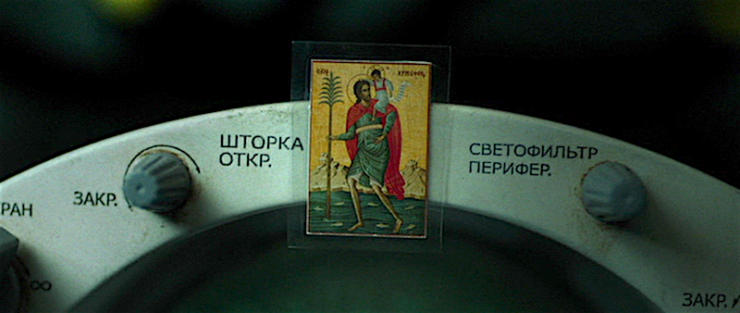
The ikon is of St. Christopher (patron saint of travelers, and happy passenger in Catholic-driven cars across America) carrying Jesus across a river. This is a common ikon in Russian Orthodoxy, but it also kind of riffs on Kowalski’s last mention of the Ganges, and foreshadows Ryan’s later crash into a river. Like Otto’s idea that the numinous underlies all religions, Gravity very much wants to throw every faith into a blender. Meanwhile, China’s Tiangong Station has a small statue of Hotei, the laughing Buddha of the Zen tradition. These representations are probably fairly accurate, as, depending on the crew, the ISS does often display iconography including Russian Orthodox ikons along with photos of Yuri Gagarin. And while China is fairly atheistic, officially, the Zen tradition is still strong there, so if they were to include a Buddha or bodhisattva it would most likely be this one.
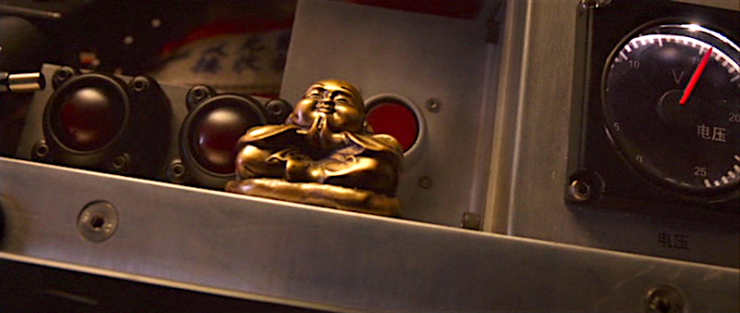
Though Ryan herself doesn’t comment on these icons, the camera rests on each of them and leaves a space for the audience to register them and draw conclusions. Every single item in space is precious—it’s hard to bring things up, it’s expensive, and astronauts have strict personal item rations. The Americans chose to take up space with a snarky pop culture reference. The Russians brought a paper card of a saint to watch over their mission, while the Chinese brought what appears to be a small brass statue—the heaviest one of all—and then taped him down.
I wrote about Gravity’s weird gender hang-ups in my other space essay, but I think its real purpose was to be a meditation on grief and faith, and Cuarón decided to make all of it more immediate and desperate by shooting his grieving protagonist into space. Really the movie could have been on a deserted island during a typhoon. Ryan Stone could have broken down in Death Valley and walked through the desert. She could have been stranded in a rainforest. It’s just that space is the most extreme condition to put a human in, and it worked to peel back every defense and veneer she had.
It doesn’t take long. She panics, and then after being rescued by George Clooney’s Matt Kowalski, she blurts out extremely emotional information that somehow they’d never discussed before, including the death of her young daughter. Obviously, in a realistic space film, she and the rest of the astronauts would have been training together for months. All of their past histories and potential emotional explosions would have been dealt with, precisely so it wouldn’t compromise them during an emergency, and the present action would be about MacGyvering a solution to the emergency—you know, like in The Martian. Instead, the backstory has been withheld so we can learn that Ryan Stone is a heartbroken woman who has come to space to escape the memories of her daughter, who has no family, no friends she mentions, seemingly no reason to want to live. The present action of the film is Stone dealing with her grief, deciding whether she wants to live or not, and trying to determine what gives her life meaning.
After a series of space mishaps, she ends up alone in a Soyuz capsule, believing that a trip home is impossible. She makes contact with a HAM radio operator—in Greenland, of all places—and murmurs to him as thought she’s in a confessional:
I know, we’re all gonna die. Everybody knows that. But I’m going to die today. Funny that… you know, to know. But the thing is, is that I’m still scared. Really scared. Nobody will mourn for me, no one will pray for my soul. Will you mourn for me? Will you say a prayer for me? Or is it too late… ah, I mean I’d say one for myself but I’ve never prayed in my life. Nobody ever taught me how… nobody ever taught me how…
She decides to kill herself rather than keep trying to get back to Earth, and specifically says that she’ll be joining her daughter. So in contrast to Ellie Arroway’s determined agnosticism, Ryan Stone sees a spiritual side to existence—or at least has a philosophy that allows for an afterlife. I point this out only because, as I said, she takes no notice of any of the religious iconography. She doesn’t discuss religion with Kowalski as he floats away to his death (even when he talks about seeing the sunlight on the River Ganges, a holy site in Hinduism), and she explicitly says she doesn’t know how to pray—which implies an extremely secular upbringing for someone who’s from the American Midwest. Even Ellie Arroway recounts being sent to Sunday School…at least until she was asked to stay home for asking too many questions about where Cain could have gotten a wife.
This turns when Ryan has either a hallucination or a visitation from Kowalski. She listens to him as he gives her the info she needs to go home. And then, once she wakes up and cranks her oxygen back up, she talks to Kowalski:
Hey, Matt? Since I had to listen to endless hours of your storytelling this week, I need you to do me a favor. You’re gonna see a little girl with brown hair. Very messy, lots of knots. She doesn’t like to brush it. But that’s okay. Her name is Sarah. Can you please tell her that mama found her red shoe? She was so worried about that shoe, Matt. But it was just right under the bed. Give her a big hug and a big kiss from me and tell her that mama misses her. Tell her that she is my angel. And she makes me so proud. So, so proud. And you tell her that I’m not quitting. You tell her that I love her, Matt. You tell her that I love her so much. Can you do that for me? Roger that.
Dr. Stone doesn’t really use her technical knowledge to save herself. She doesn’t rationally think through her problems. She panics, reacts emotionally to everything, focuses repeatedly on her daughter, and finally only lives because of a hallucination/vision of a dead man who tells her what to do. She then immediately takes said dead man and turns him into a personal intercessory saint, who will speak to her daughter, who is now an “angel.” You can easily interpret Gravity as a story of faith, and plenty of people have, but I would say that it plays more into the sense of the numinous than any of the other films on the list, because Stone’s faith isn’t in anything in particular. She crashes the capsule in a lake, a scene that serves as a death/baptism/rebirth/evolution combo pack, and as she crawls onto the shore she says, “Thank you”—but who or what is she thanking?

Interstellar riffs on Contact and 2001, was similarly overstuffed in the way I can’t help but love (plus it casts Matthew McConaughey as astronaut-turned-farmer Coop), and like those films it dives headlong into a numinous approach to space (and time) travel. The film already had more than enough already going on, what with “the Earth is dying, but can I interest you in a wormhole” and “the last of the okra’s gone” and “here are three possible planets humanity might survive on” and “HOLY SHIT THAT ISN’T A MOUNTAIN IT’S A FUCKING TIDAL WAVE” not to mention “MUUUUURRRRPHHHH.”
But that just wasn’t enough for Chris Nolan. He had to add in “love isn’t quantifiable but IT’S TOTALLY REAL” when Dr. Brand finally snaps and opens up to Cooper about her love for Dr. Edmunds:
We love people who’ve died … where’s the social utility in that? Maybe it means more – something we can’t understand, yet. Maybe it’s some evidence, some artifact of higher dimensions that we can’t consciously perceive. I’m drawn across the universe to someone I haven’t seen for a decade, who I know is probably dead. Love is the one thing we’re capable of perceiving that transcends dimensions of time and space. Maybe we should trust that, even if we can’t yet understand it.
Which echoes the pro-God argument Palmer Joss used on Ellie Arroway back in Contact:
Palmer Joss: Did you love your father?
Ellie Arroway: What?
Palmer Joss: Your dad. Did you love him?
Ellie Arroway: Yes, very much.
Palmer Joss: Prove it.
And when even that isn’t enough, he sprinkles on some “inter-dimensional beings are saving us—except the inter-dimensional beings were us all along.” He even includes a scene of Dr. Brand looking at said inter-dimensional beings that explicitly mirrors John Glenn looking out at his space fireflies. And of course, Amelia Brand’s hunch about love turns out to be correct.
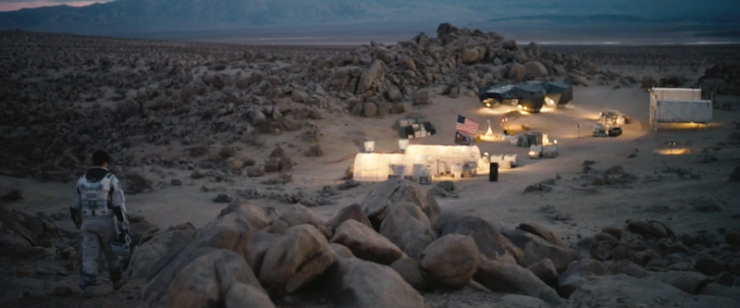
Dr. Brand’s partner, Edmunds, not only survived his trip, but built the beginnings of a colony while he waited for them to join him. If they’d trusted Dr. Brand’s intuition and gone to his planet immediately, they all would have survived the trip, they would have found a habitable planet to continue building on, and hell, maybe they would have even gone back to rescue Matt Damon at some point. Coop could have made it back to MUUUURRRRPHHH while she was still in her Jessica Chastain form, thus saving her from decades of anger. He could have organized colonist missions to Dr. Brand’s planet while his daughter worked out the math to save humanity.
But no—Dr. Brand made a purely emotional, quasi-religious argument in an otherwise realisticish film, and the men rippled their jaw muscles and outvoted her…but then were perfectly happy to go full MAGIC BOOKCASE a few scenes later.

Cooper, in submitting to the direct, transcendental experience of the tesseract, is able to communicate with his daughter and save himself from limbo, but only by becoming the ghost that used to haunt his old house. He has to become the numinous. As in Contact, this was not the film I was expecting. I was expecting a straight-ahead space exploration film, about environmental collapse and planetary colonization. In the final act of the film, Nolan pretty much chucks science entirely to have Coop instead learn that love does transcend quantifiable human life as he reaches across time to contact his daughter. And again, as in Contact, the love between a father and child is elevated to a near-mystical height, and allows humanity to take its next leap forward. Nolan creates a scientifically rigorous film, and puts an emotional hole in the center, which he then fills in with the Coop/MUUUURPH relationship, and, to a lesser extent, the Brand/Edmunds relationship. He chooses to meld tech and a sort of grasping hope into a film that eschews traditional religion for the idea that love can somehow guide human life.
Which brings us to the latest space exploration movie (from 2015) I want to look at, The Martian, which was actually the reason I started rolling this essay around in my head. Because this was a story that firmly rejected the melding of spirituality and space, in a way I found rather refreshing, and as soon as I learned it was getting a movie adaptation I started wondering if the filmmakers would keep that level of agnosticism.

In Andy Weir’s novel, there are only a few instances of religion coming up. The first is back on Earth, in a brief conversation during a launch between Mitch Henderson and Venkat/Vincent Kapoor. Kapoor says he believes in several gods, since his father was a Hindu and his mother is a Baptist. In both the book and the film, the scene plays out the same way, with the implication being that one or both men are hoping for supernatural assistance with the launch of the supply load that would keep Mark Watney alive until the next Ares mission. In both the book and the film, the launch seems successful for a moment, but then fails in a spectacular explosion, forcing Watney’s Hermes crew to rescue him. In both the book and the movie, this is an odd moment, a rare acknowledgement of spirituality that is somewhat undercut by the mission going so drastically wrong. It’s the point where Watney’s fate seems bleakest.
As for Watney? He is a thoroughgoing secular scientist. Despite the fact that he’s stranded on Mars with an infinitesimal chance of survival, his thoughts never turn to pondering The Big Questions in the way that Ryan Stone’s do in Gravity. He doesn’t want to die, but he’s also happy with the life he’s lived; he doesn’t regret coming to Mars. He asks Martinez (in the book) or Commander Lewis (in the movie) to deliver a letter to his parents that just says that they were great and he misses them, but to stress that he doesn’t regret his mission or his fate. He sets enough drugs aside to suicide if he needs to. Later, once his potatoes start to grow, he falls back on Scott Carpenter’s old phrase, telling them: “Godspeed, little taters. My life depends on you.” (In a book that resolutely resists having Watney anthropomorphize his cameras, or draw a face on a space volleyball, he does speak directly to the only other biological life on Mars.) He becomes pretty openly depressed as the days tick by, but he never has any sort of epiphany, or consults any kind of deity. We know he doesn’t because of the one moment when religion does come up.

Watney needs to make fire to create a mini-atmosphere to get his potato crop to grow. The problem is that NASA is extremely anti-fire (fair enough) and flammable objects are prohibited. In the book, Watney meditates on the irony that their safety precautions are going to kill him, but then decides to loot his friends’ stuff:
After a search of everyone’s personal items (hey, if they wanted privacy, they shouldn’t have abandoned me on Mars with their stuff) I found my answer. Martinez is a devout Catholic. I knew that. What I didn’t know was he brought along a small wooden cross. I’m sure NASA gave him shit about it, but I also know Martinez is one stubborn son of a bitch.
So now that he has something to work with, he might live. In the book, the next sentence reads: “I chipped his sacred religious item into long splinters using a pair of pliers and a screwdriver.” He doesn’t record hesitating or thinking this over—he needs the wood to survive, so the wood gets chipped. In the next sentence, he pairs one brief rumination on the sacred with some typical snark: “I figure if there’s a God, He won’t mind, considering the situation I’m in. If ruining the only religious icon I have leaves me vulnerable to Martian vampires, I’ll have to risk it.”
So we have a character who is clearly agnostic, even when he’s enduring months of near-death panic—an agnostic in a Martian foxhole, if you will. Agnostic to the point that he chooses to enter a vampire joke into the official record of his time on Mars.
I’m saying agnostic this much to make a point. I’ll admit that I was interested in seeing how they translated that scene for the movie. Whatever the intentions of Ridley Scott and the rest of the filmmakers, having your hero desecrate a religious symbol—even if he has a really good reason—is going to be a hard sell for U.S. audiences. And they did, in fact, make a couple of small but fascinating changes.
First of all, Martinez’s cross is now a crucifix, which means that rather than simply chipping a small wooden icon Watney now has to hack into the actual face and body of Jesus, or at least pry the metal body off and then slice the cross itself apart. This is a very different visual than simply shaving a piece of wood apart. When I saw this during the movie the change startled me but the reasoning quickly became apparent: rather than simply splintering the crucifix, or even getting to work de-Jesusing the cross, he first lies in his bed holding the crucifix and gazing into the face of Jesus, and says: “I figure you’re OK with this, considering my circumstances. Countin’ on ya.”
In this one, ambiguous moment, Watney goes from being utterly secular and agnostic to either A) speaking directly to the cross in his hand, the same way he talks to his cameras, potatoes, the Rover, and Mars itself or B) praying to the central icon of a specific monotheistic religion. Obviously, given how little agnostic representation there is in U.S. film (Tony Stark, I guess? But even he’s close personal friends with an actual Norse God, so….), it was surprising to see how this one tiny moment shifted the movie enough, basically turning a nervous joke from the book into a prayer, and allowing room for a religious interpretation to that scene and everything that comes after it. Because when Watney creates fire, he’s able to grow his potatoes, and even though there’s a disaster later, the extra plants he grows are what allows him to live long enough to be rescued. By shifting this line, the filmmakers have allowed for the possibility of divine help, and rather than giving us a vague wave at the numinous as Kaufman did back in 1983, have instead inserted a particular religious figure as a symbol of that help.
Awe-inspiring Space Stories
So why is it that these films need to make room for the numinous?
Given that in reality, the space program made room for people of many different faiths—or no faith—why do the films about this history (real or imagined) insist on falling back on spiritual imagery? Is it that, faced with the vastness of space, the human mind instinctively reaches for something beyond materialism?
In The Martian I think we find a more prosaic answer: Hollywood, rather than committing to telling a purely secular story of scientific advancement, finds a way to make sure that audience members of a religious persuasion feel that their perspective is being honored.
But The Martian is unique in this. The rest of our films of space exploration reach back toward the language of the numinous, and Cosmism, in order to express the awe at the heart of humanity’s journey into space. However clumsily these images are used in The Right Stuff and Gravity, they still create a sense of the uncanny joy and terror of leaving Earth behind. Contact uses a story of space exploration and alien communication to explore the tension between science and religion in America, and Interstellar attempts to blend a story of emotional connection with theoretical musings on the structure of the universe. To me, these films all try for the emotion that’s summed up in the phrase Godspeed, balancing on a razor’s edge between scientific fact and emotional yearning.
Is it simply that the act of going to space is so awe-inspiring—so literally otherworldly—that writers and artists reach toward theology even when telling secular stories?
[1]Twenty years later, short story author and typewriter enthusiast Tom Hanks produced an HBO miniseries about the space program called From the Earth to the Moon, which dramatized the reading in a very different way. The episode is titled simply “1968” and follows the turmoil around the Democratic convention and the assassinations of Dr. Martin Luther King, Jr. and Robert Kennedy. The show presents the Genesis reading as a moment of healing, as the entire nation comes together to watch the broadcast. It’s an interesting interpretation, given that it was much more likely another point of turmoil as the country wrestled over its identity.










